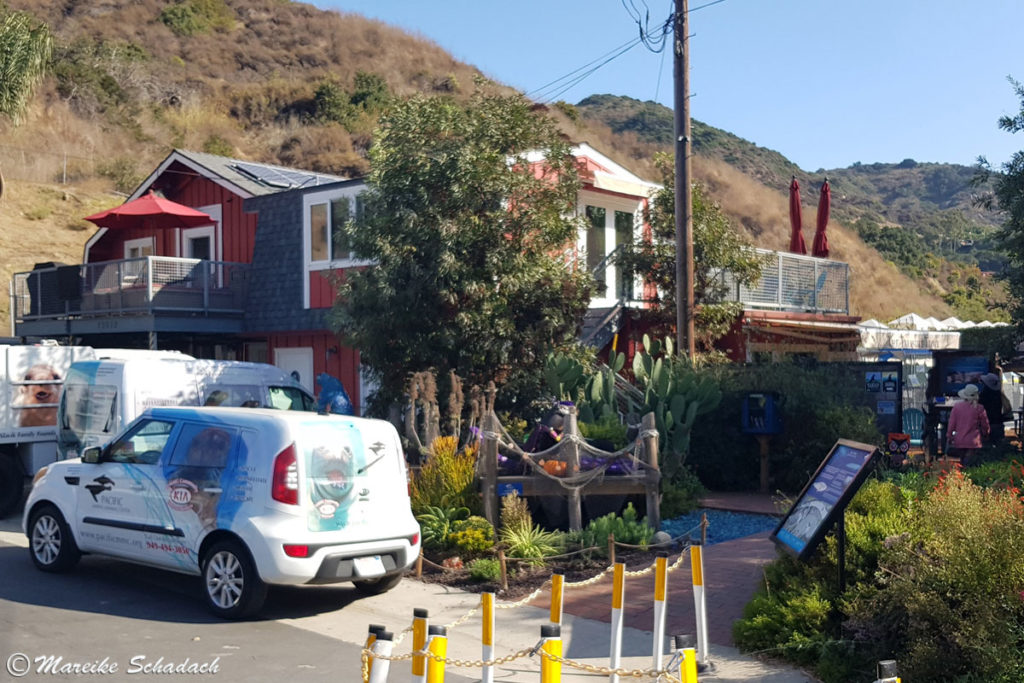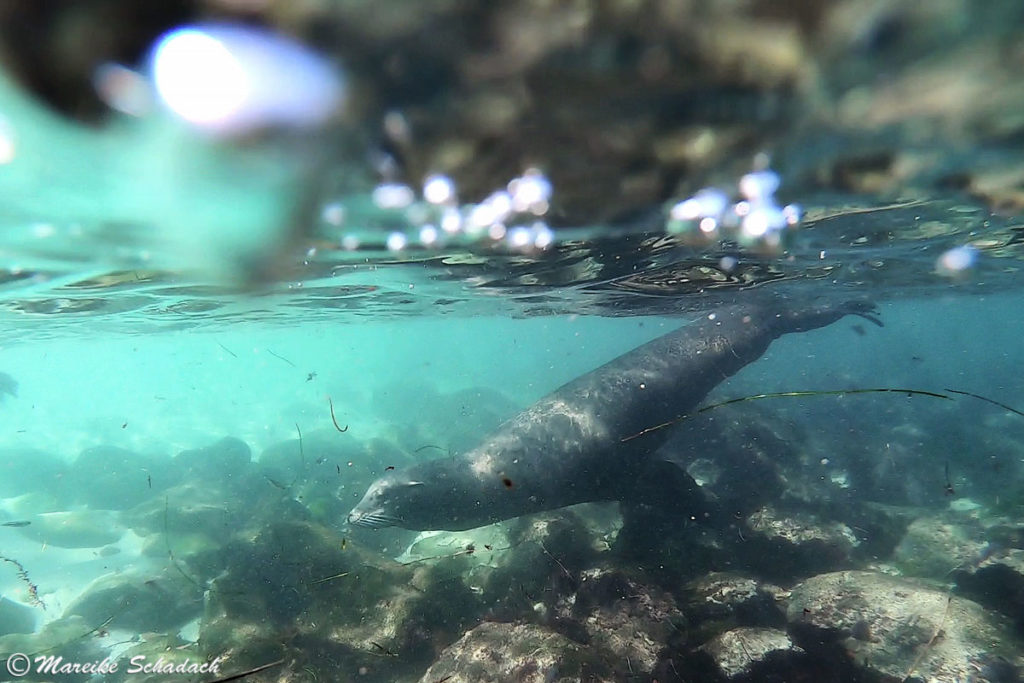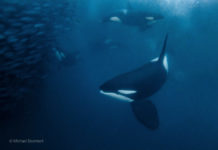Observing and snorkeling with the sea lions of La Jolla, San Diego, impressed me a lot. Now I wanted to learn more about our marine mammals. Therefore I planned to visit the Pacific Marine Mammal Center in Laguna Beach, Orange County. Here sick or injured seals are taken in. Afterwards they are cared for until they can be released into the wild again. I am glad that this place exists. With my article I would like to draw your attention to the Pacific Marine Mammal Center, its fosterlings and its important work. At the same time you will learn what dangers the seals are exposed to and what each of us can do for our marine mammals.
Table of Contents and Quick Navigation
The Pacific Marine Mammal Center
Welcome in the Visitor Area
When does a Seal need Help?
Patient Care
Back to the Sea - the Release of the Animals
Public Relations and Education
More Marine Wildlife Rescue Centers in California
The Pacific Marine Mammal Center
The Pacific Marine Mammal Center is responsible for all marine mammals along the Orange County coastline. The reception station has a capacity for up to 100 animals. Every year, the Mammal Center takes care of 250 to 300 marine mammals. These include seals, sea lions, elephant seals and sea bears. The center is primarily run by volunteers.

Welcome in the Visitor Area
As soon as I enter the visitor area of the Pacific Marine Mammal Center, I am welcomed by one of the volunteers working here. After a short introduction he leads me through the station. First I get to know the seals, then I go up to the training room and then again to the open visitor area. I got a lot of information about the seal species that are recorded here, what happened to the current patients and about the work in the Marine Mammal Center. In addition, numerous information boards provide information about the animals and life in the sea.
During my visit there were three seals and twelve sea lions in the station. The majority of the patients were puppies under one year of age. They were stranded on the beaches of Orange County in the spring and suffered from dehydration and malnutrition. Six of the patients were to be released into freedom on Laguna Beach next weekend.
Visit to the Pacific Marine Mammal Center:
Address: 20612 Laguna Canyon Road Laguna Beach, CA 92651
Opening hours: daily from 10 a.m. to 4 p.m.
I could see most of the patients from the visitors area. However, it can also happen that not all patients are visible from the visitor area. If animals are in a critical condition, they are first cared for in the intensive care unit.
A visit to the Pacific Marine Mammal Center is free of charge, but donations are welcome. The center also has a small shop where you can support the center by shopping.

When does a Seal need Help?
A sick or wounded seal will try to get to the beach. But seals also come to the beach to rest, warm up, mate, give birth or change coat. So not all seals lying on the beach need help. Here a trained look and if necessary longer observation is necessary, in order to recognize the needy animals.
There are various reasons why a seal or sea lion may need help:
- Human-induced injuries
- Malnutrition / dehydration. An animal that unfortunately could not be rescued had its stomach full of plastic and died of starvation.
- Injury by fishing tackle or entanglement in fishing lines / hooks
- Caught in fishing nets
- Caught in plastic waste
- Infection with parasites
- pneumonia
- poisonings
- bites of sharks
- Lost helpless young animal (e.g. seek a storm at sea separated from mother)
- young animal, which is not yet able to cope alone after cutting the cord from its mother
Example Sea Elephant:
Sea elephants spend almost their entire life in the sea. They only come ashore to mate and give birth to their young. The young are suckled for four months. The mother then leaves the young. The young must now manage on their own and learn to hunt the food. But some kittens learn this too slowly. If they are lucky, the half-starved animals are found on the beach and then taken to the rescue station. Here the keepers teach them how to hunt for fish, so that they can cope alone in nature afterwards.

Patient Care
The animal is then thoroughly examined in the reception station and wounds are treated. Most patients suffer from malnutrition and/or dehydration. They are first fed with a mixture of electrolytes, proteins, glucose and vitamins via a stomach tube. As soon as the animals are in a more stable state again, they are fed fish three times a day. If necessary, medicines are mixed into the fish.
The seals are marked by a special shave in the fur, so that each can get its individual treatment and if necessary medicine.
On average, the animals spend four months in the sanctuary before being released back into the sea. But sometimes there are also animals that would not survive in the wild. For example, if the animal only has severely impaired vision or has suffered too severe damage. Then, after extensive recovery, it is transferred to a zoo or aquarium.
The caretakers of the animals try to avoid direct contact between seals and humans as far as possible. For example, when feeding, the person holds a black board in front of him. This prevents the animal from associating the food with humans. However, if an animal later comes to the zoo, contact with humans is encouraged through feeding and play.
Back to the Sea - the Release of the Animals
As soon as the wounds have healed, the animal has a healthy weight and successfully competes for food, it can return to freedom. Before release, each animal is given an orange tag with an identification number: the females on the right pectoral fin and the males on the left. The number helps, for example, to identify the animal if it needs help in the future.
The release of the recovered animals is always a solemn event. On the website of the Pacific Marine Mammal Center you can watch several “Release-Videos” . Sometimes the sea lions run towards the water. Another time they don't really know what to do. In a video, three released sea lions push together into a transport box and have to be shaken out again by the keeper. But no matter how the animals reacted, the shots were always very moving. The dates for the release of the animals are announced however only to the promoters and/or members.
Excursus: Under Water
Not only whales and dolphins dive deep. Also seals can reach amazing depths and dive times.
Sea lion (California Sea Lion) - 100 m - 20 minutes
Northern Elephant Seal - 1600 m - 120 minutes
Seal (Pacific Harbor Seal) - 460 m - 40 minutes
Sea Bear (Fur Seal) - 200 m - 90 minutes
More photos of sea lions can be found in my article about the "Sea Lions of La Jolla - Tips for Observing and Snorkeling".
Public Relations and Education
Man only protects what he knows. That's why I think it's especially good that the Pacific Marine Mammal Center also receives and informs visitors. Especially moving are the stories of the individual patients, which are told here by means of pictures. With other free educational programs for children and young people, it makes an important contribution to the development of environmental awareness. The proximity to the animals opens the hearts and creates a connection to nature.
When I was in the States (California) for the first time in autumn 2019, I was shocked by the amount of plastic waste that is produced here every day with a frightening matter of course. Disposable items are used everywhere, even in some restaurants at the tables. Unfortunately, not all of these disposable items and packaging end up in the trash can. In the center I learned that the beach of Laguna Beach has to be cleaned of garbage every day. On days when seals are released, volunteers clean the garbage from the beach. The Pacific Marine Mammal Center therefore explains the problem of plastic waste to its visitors on information boards. Pictures of seals or other animals that have got caught in the plastic open their eyes and hopefully encourage a change in thinking. In interactive games, children also learn how the rain can wash the discarded plastic articles into the sea.
More Marine Wildlife Rescue Centers in California
Pacific Marine Center is not the only marine mammal rescue center in California. There are several stations along the coastline.
- Humboldt and Del Norte Counties – North Coast Marine Mammal Center
- Los Angeles County – Fort MacArthur Marine Mammal Care Center
- San Luis Obispo and Mendocino Counties – Marine Mammal Center
- San Diego County – SeaWorld
- Statewide Whale Rescue Team
- Ventura County – Channel Islands Marine and Wildlife Institute
The Marine Mammal Center in San Luis Obispo and Mendocino Counties also welcomes visitors. There is also a visitor center near San Simeon dedicated to elephant seals. Every year the animals come here to the beach and can be observed well. Young animals can be seen especially well from September to December.
I would never visit SeaWorld because of its highly controversial attitude towards orcas and its shows with the animals. However, I also highly appreciate that SeaWorld is part of the marine mammal rescue network on the California coast. Rescue teams are available around the clock for orphaned, sick, injured or dependent animals. The animals are rehabilitated for return to the wild. However, animals whose injuries are too severe and who can no longer be released into the wild are cared for here for life.
Have you ever been to a sea lion rescue center yourself? How did you like it? Do you have any questions about my article or suggestions? If so, please write me a comment!








